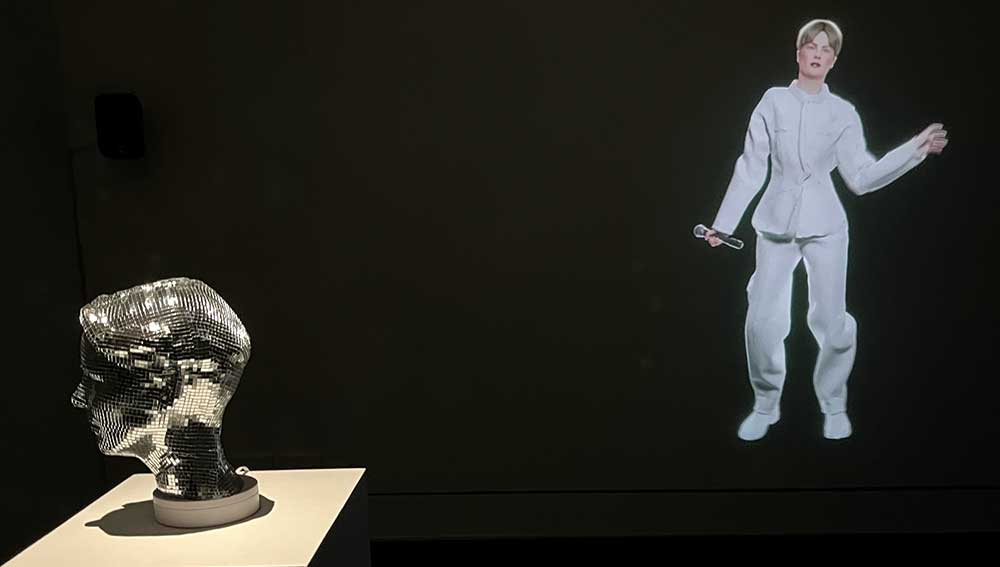
MV Brown, installation view, Jerwood Survey III at Southwark Park Galleries, London. Photo: Veronica Simpson.
Southwark Park Galleries, London
6 April - 23 June 2024
by VERONICA SIMPSON
Four years on from a global pandemic and it feels as if there is a body of really interesting work appearing in galleries that bears witness to a period of few distractions and little or no geographic movement. This is especially true of work from younger and emerging artists, which demonstrates a richly layered and personal response to the cultural, political, economic and ecological turbulence of the times.
The fruits of this period of expanded bandwidths, fertile introspection and experimentation are very much apparent in this Jerwood III biennial survey show at Southwark Park Galleries.
It features 10 “early career” artists (who are either between three and 10 years out of formal education, or later-starting artists a few years into their evolution), all of whom have been nominated by peers, the latter including rising stars Alberta Whittle and Sin Wai Kin and 2021 Turner nominees Gentle/Radical. From a nominated list of 40, the 10 artists showing here were selected by a panel and commissioned to produce the show’s eclectic range of film, sculpture, drawings, paintings, installations and works on paper, which will travel to three other UK locations over the following 16 months. A programme of supported events at each location links the exhibiting artists with audiences and networks across the country – including Scotland, for the first time, when the tour concludes at Collective in Edinburgh in May 2025.
The inaugural show for Jerwood Survey III is arranged across Southwark Park’s two galleries, the Lake Gallery and the Dilston. The latter is a tastefully light-touch refurbishment of an atmospheric Grade II listed church from 1911, the first structure in England to use poured concrete. Its stripped-back, cavernous interior and semi-ruined aesthetic make for an austere and gritty setting for the four rather sensual works arranged here, from artists Philippa Brown, Alliyah Enyo, Paul Nataraj and Sam Keelan.
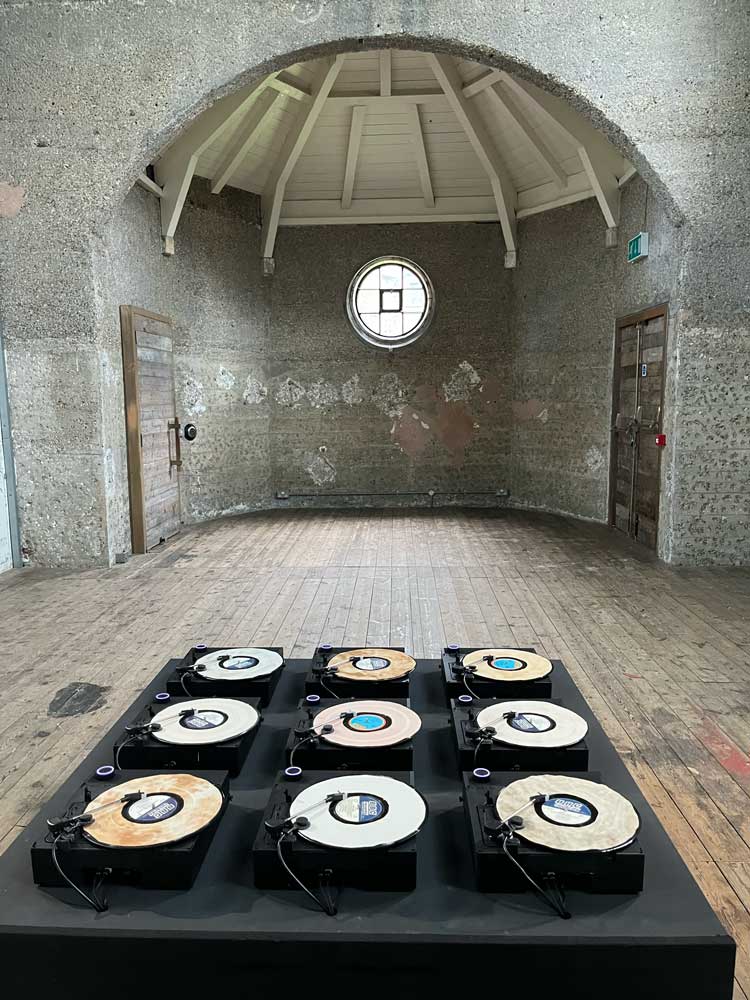
Paul Nataraj, installation view, Dilston Gallery, Jerwood Survey III at Southwark Park Galleries, London. Photo: Veronica Simpson.
The dry, earthy rumble and rasp of Nataraj’s installation dominates the experience and it is the first work we encounter: nine turntables placed in a 3 x 3 formation on a black plinth (the speakers are hidden inside the plinth). What we are hearing is the contact microphones placed against the gently rotating vinyl discs (a recording of a BBC meditation programme, we learn), which have been covered in calico and dyed and stained brown with earth from Blackburn and South Asia, reflecting the artist’s dual origins. There is text and floral imagery scratched on the other side, apparently, and each day the records are flipped so that the soundtrack evolves. Vinyl is a key material in Nataraj’s practice, and he plays with its material and sonic properties to explore records as a repository of musical memory and personal and political histories.
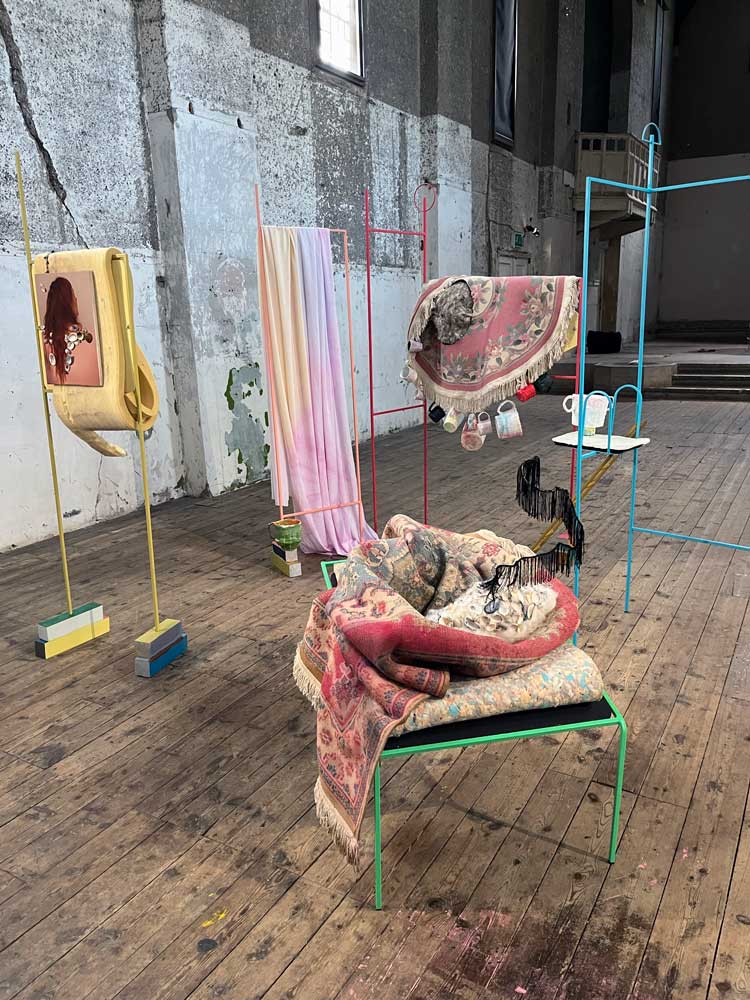
Philippa Brown, installation view, Dilston Gallery, Jerwood Survey III at Southwark Park Galleries, London. Photo: Veronica Simpson.
Cardiff-based Brown’s work occupies the centre of the church, creating an intriguing, salvage “sanctum” of found and intuitive objects expressing her themes of spirituality and outsider ways of living. Welded metal structures (with the spindly, functional quality of mid-century modern furniture but painted in fruity, sorbet colours) are draped with materials, including thickly rolled, ornamental rugs and Brown’s own hair, which features in a portrait on one of the metal frames, adorned with seashells. Like a stage set for a pastel-tinted, pretty, post-apocalypse squat, the rug segments are accompanied by hand-moulded papier-mache-styled mugs and dip-dyed curtains, setting up intriguing associations.
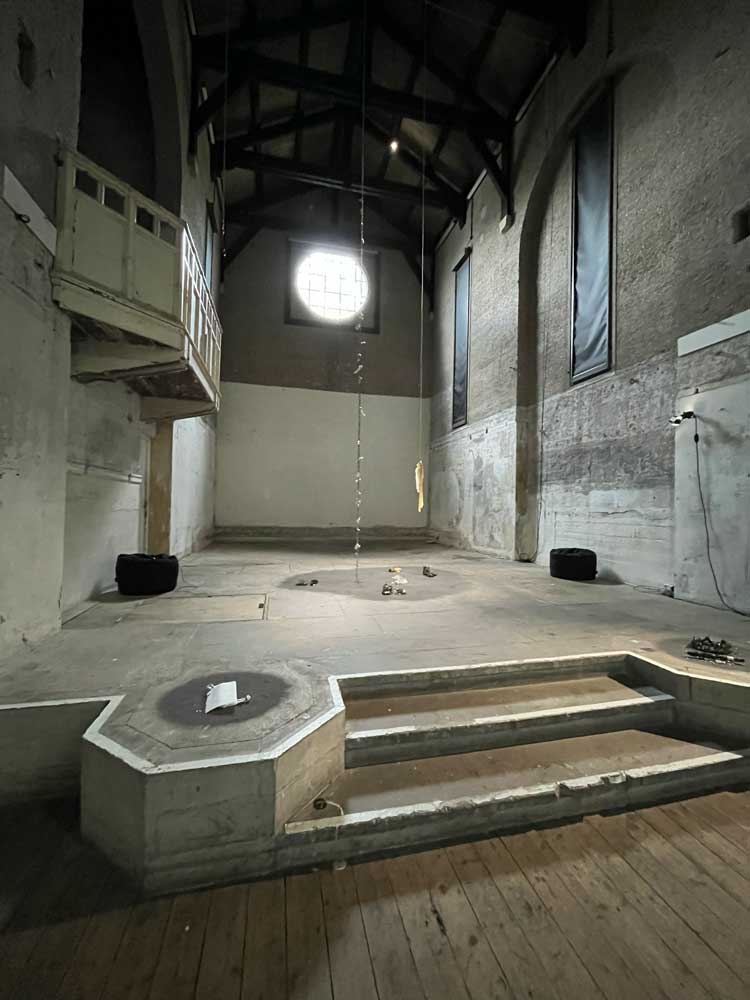
Aliya Enyo, installation view, Jerwood Survey III at Southwark Park Galleries, London. Photo: Veronica Simpson.
In the altar space, the Glasgow-based Enyo has created an installation that is also a set for performance (with one scheduled on 20 June, a few days before the exhibition closes). Enyo’s intention is to replicate a deep-sea space inaccessible to humans, but featuring precious objects that have presumably been lost and found their way there, from scrolls to pewter and ceramic vessels with a blackened or silvery lustre, some of them seemingly set within a fire-blackened, sacrificial circle. An otherworldly soundscape is provided on headphones, and well worth a listen for its celestial voices and captured fragments of wilderness and wildlife. A compelling experience, it is hard to imagine that the other exhibition spaces for this tour will pack quite the dystopian punch of this gloomy, concrete nave.
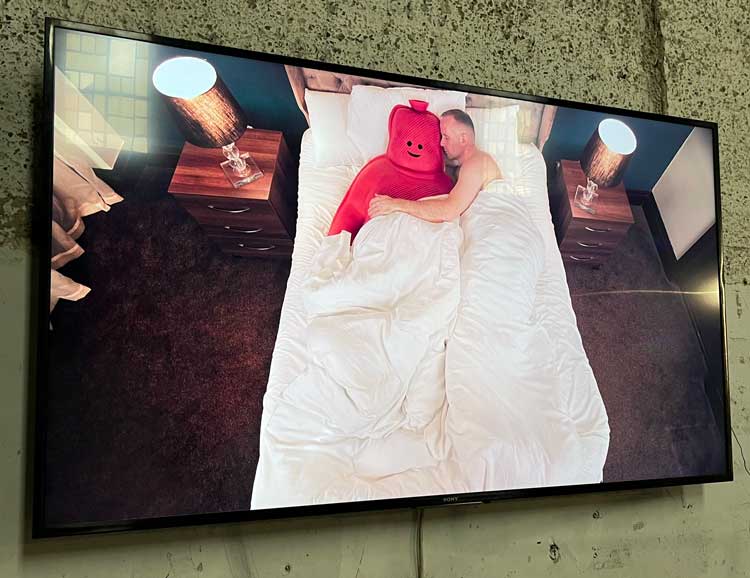
Sam Keelan, installation view, Jerwood Survey III at Southwark Park Galleries, London. Photo: Veronica Simpson.
Quietly exuding calm and a surreal intimacy, on a side-wall screen, is a two-hour-long filmed performance by the Huddersfield-born Royal Academy graduate Sam Keelan. Throughout the 30 minutes or so that I spent exploring the gallery, it seemed to be showing the same scene: an actor fast asleep, in a big comfy bed, cuddled up to a giant, bright red, life-sized hot-water bottle. Keelan, who is London-based, works in photography and film, exploring individualism, care and community. It takes a laudable confidence and skill to make a film in which so little happens as mesmerising and touching, in its way, as this one. Not that I would want to spend the two full hours watching it.
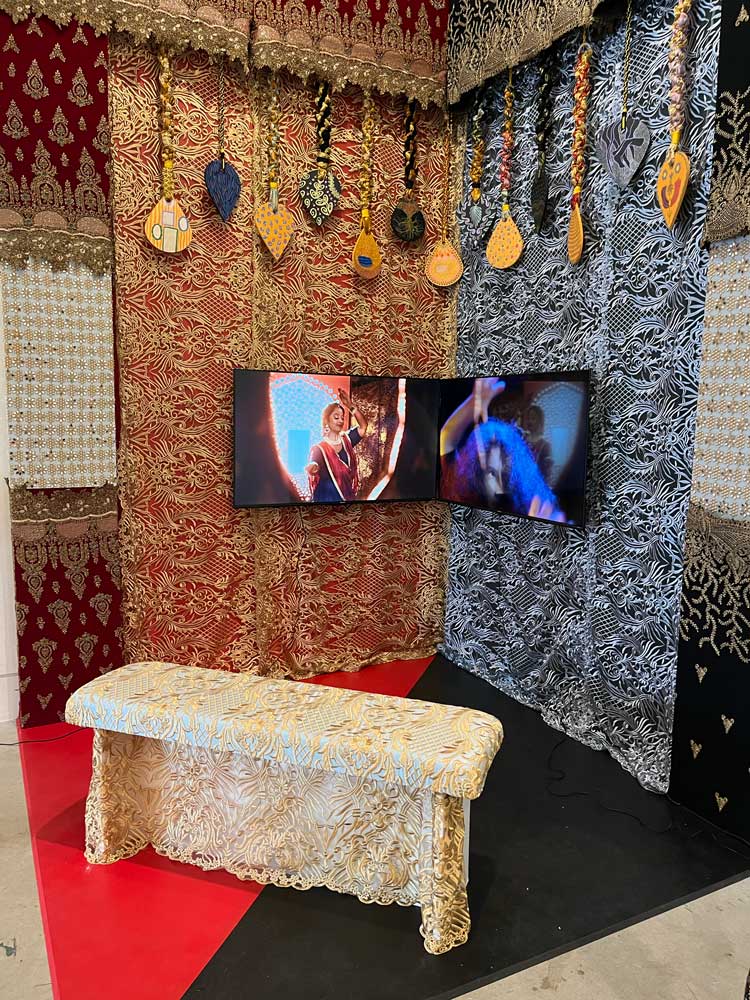
Aqsa Arif, installation view, Jerwood Survey III, Southwark Park Galleries, London. Photo: Veronica Simpson.
Over to the white-brick Lake Gallery, in the centre of Southwark Park, a white-cube-style space where the other six artists are featured. The work of Aqsa Arif dominates the entrance. A Pakistani refugee who graduated from Glasgow School of Art and is now based in the Scottish city, Arif has established a strong reputation there for work that mixes film, printmaking, photography, poetry and dance. Her art references traditional folklore and mythologies, with cinematic presentations including this, her first showing in London. Set within a sumptuous arrangement of embroidered and knotted fabrics, a solo female dancer acts out scenes from the lives of two mythological females, Marvi and Churail, one on each screen. The narratives are obscure to the uninitiated, but the mood of the films is captivating, particularly a scene in which both characters begin to move their arms and hands simultaneously, echoing each other, and drawing links with a nearby sculpture by Ebun Sodipo, whose work explores the experience of black trans women. Here, the artist has created a bronze of clasped hands, layered together in a gesture of supplication and friendship. Created with the help of 3D scanning, the unusual grooves and striations in the sculpture also evoke the feel of wood, and it is presented on a tall plinth clad in sparkling, blue velveteen.
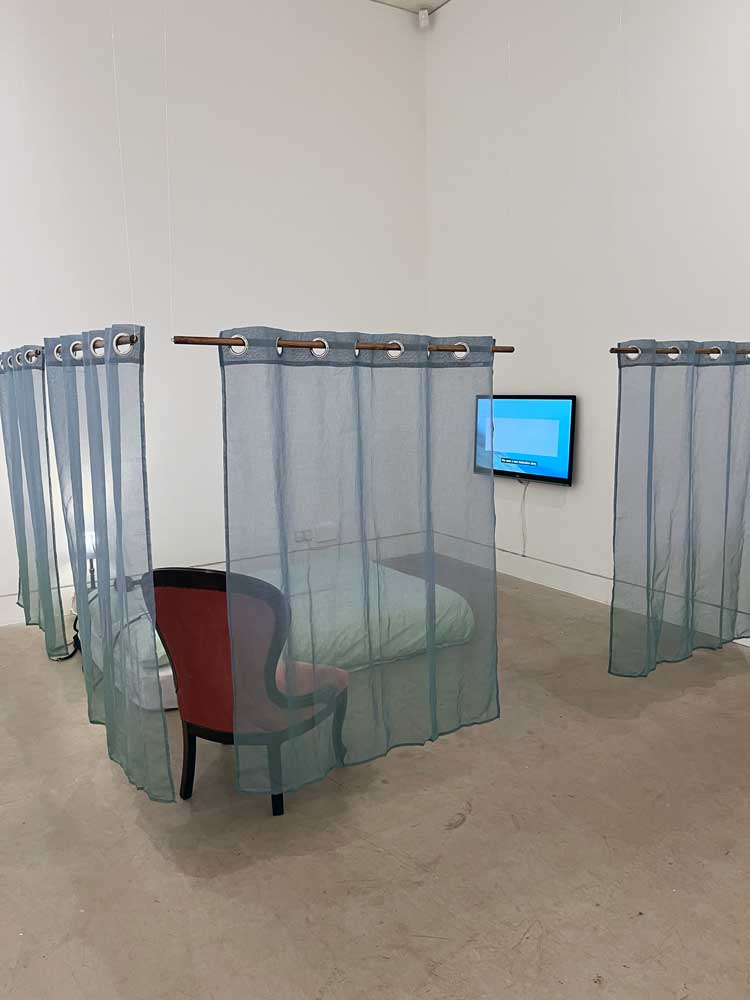
Kandace Siobhan Walker, installation view, Jerwood Survey III at Southwark Park Galleries, London. Photo: Veronica Simpson.
A free-floating frame of gauzy, blue curtains creates a tranquil bedroom or den-like setting for an ecological meditation in film by the Jamaican-Canadian and Welsh artist, Kandace Siobhan Walker, accompanied by three painted wall works. There are two headphones resting on soft green pillowcases, which match the duvet on a double mattress placed on the floor. Her narrative looks at both the “doomer” (here comes the apocalypse and we can’t do anything about it) mentality as well as the “dreamer”, with the emphasis very much more on the dreamer, spinning positive stories of resilience and survival. Phrases that stayed with me included: “What’s required now is scale and perspective” and “What happens to one happens to us all,” announced in a confident, clear voice, with no other background music or soundscape to influence your experience.
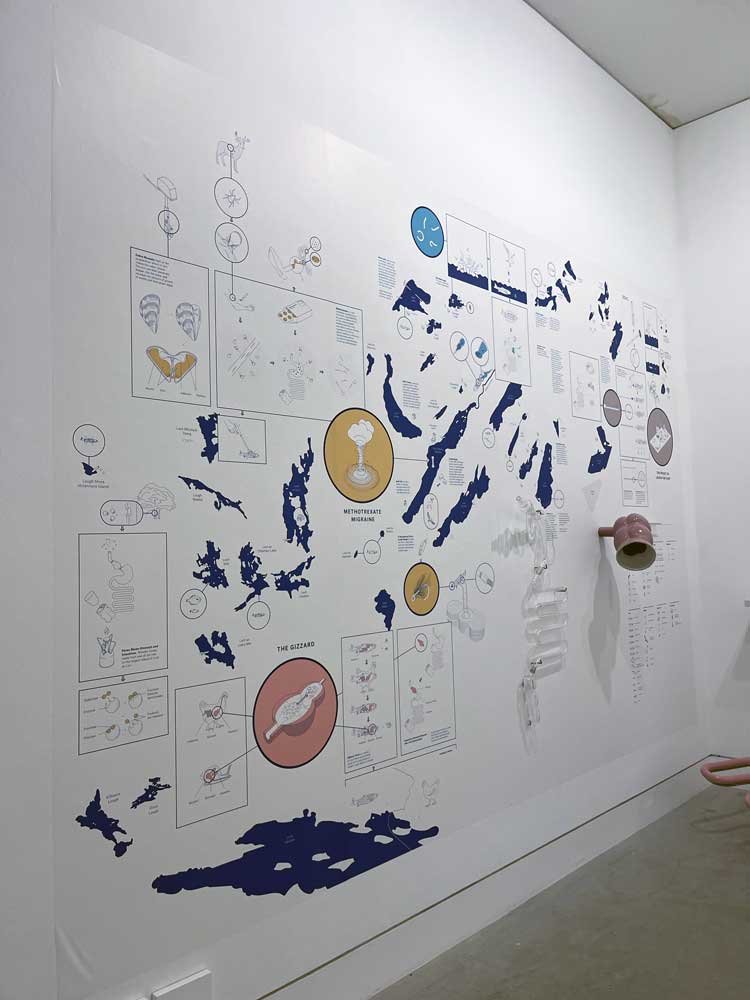
Ciarán Ó Dochartaigh, installation view, Jerwood Survey III at Southwark Park Galleries, London. Photo: Veronica Simpson.
Ciarán Ó Dochartaigh’s work explores personal experiences of bodily trauma, medicalisation and invasive surgery, weaving these stories into reflections on the landscape of his Northern Ireland homeland. Beautifully crisp, graphic depictions of lakes and sea creatures and stomachs are scattered across a wall, along with accompanying texts as well as tubular sculptures in glass and pink ceramic. It is hard to pick out any clear storylines, or discern fact from fiction, but there is a lingering impression of conflict in processing materials, of afflictions within our digestive capacities conversing with humankind’s colonising of the landscape and the food we extract from it.
Around the corner is an amusing Karaoke performance by MV Brown, called System of Touch. It comprises a digitally modelled sculpture of the artist’s head, clad in mirrorball reflective tiles that bounce around the room as her white-suited, digitally reproduced avatar sings and dances on the screen.
If there is any work that doesn’t quite sing in these spaces, it’s Che Applewhaite’s conceptual presentation of six, scantily typed pages, a cluster of photos printed on to three further pages beside them. Given the obvious visual and sensual enticements of all the work around Applewhite’s, it can seem slight in comparison. But it is quite possible that in the other three spaces (see below for details), each of which will have its own curatorial approach, this work might be made to stand out more. Clearly, though, the selectors have picked some intriguing talents.
• Jerwood Survey III will be at g39 in Cardiff from 13 July to 7 September 2024, Site Gallery in Sheffield from 27 September 2024 to 26 January 2025, and Collective in Edinburgh from 28 February – 4 May 2025.